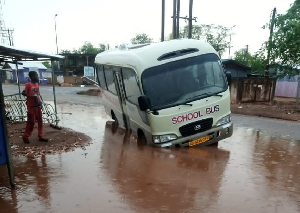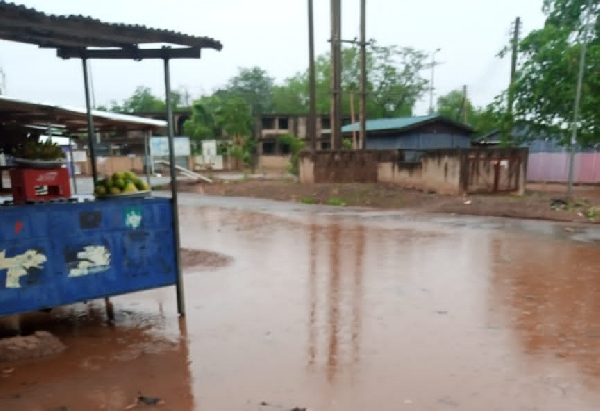 A situation of the road after a heavy rainfall
A situation of the road after a heavy rainfall
Correspondence from Upper East:
Commuters at the Bolga Preparatory School T-junction leading to the GRA office in Bolgatanga, Upper East Region, are frequently stranded after any significant rainfall, as their movements are impeded due to flooding at the junction.
According to residents, the drains in the area become choked during downpours, causing water to overflow onto the roads. The scene becomes particularly troubling for motorists, who often struggle to navigate through pools of water, creating dangerous conditions.
A visit to the area on a rainy day revealed the struggles of unsuspecting road users, especially motorcyclists, who attempt to manoeuvre through the waterlogged roads.
Traders and shopkeepers in the area are also heavily impacted, as the water floods their storefronts, and disrupts business.
Gregory, a local shopkeeper, shared his frustration with GhanaWeb's Sarah Bandal Dubure, noting that the gutters were poorly constructed from the beginning.
"When the gutters were being built, we raised concerns. We predicted that the gutters would become silted if they didn’t complete the tarring up to the Preparatory School area, but they promised to fix it and didn’t follow through," he explained. "One side is up to standard, but the other is too shallow."
Gregory added that the overflowing gutters cause significant problems for both storekeepers and road users alike.
"Whenever it rains heavily, the gutters overflow, and everywhere gets flooded. Motorists struggle, and some even crash when trying to avoid potholes hidden under the water."
Mr Gregory believes that desilting the gutters could be a temporary solution to prevent further flooding.
Road user Atambila Nyabire described how dangerous the situation could be for first-time commuters in the area, sharing a personal experience where he was forced to take an alternative route to avoid the flooded junction.
"One rainy day, I was headed to the hospital, but the place was flooded. I turned back because I knew my motorbike could easily fall into a gutter. I had to take a longer route through the Nursing Training School area to get there safely."
Madam Lariba Atia, another resident, echoed similar concerns, pointing out that the flooded gutters make it nearly impossible to distinguish between the road and the drains.
"When it rains, the area becomes a death trap. You can't see the road, and motorbikes fall into the gutter regularly," she lamented, recalling a terrifying incident where a school bus full of students plunged into the drain after the driver failed to see the road.
Another resident, Madam Felicia, stated that the size of the drains is too small to handle the volume of water during heavy rains, causing frequent overflows.
"There’s also a pipeline running through the culvert, which contributes to the blockages. It’s a serious problem, and many accidents happen because people can’t see where the road ends and the gutter begins."
The Upper East Regional Director of the Department of Roads and Highways, Mr Peter K. Amoako, confirmed that his office has been made aware of the issue and that a needs assessment has already been carried out.
"After the assessment, we found that the area requires desilting of the existing culverts. This has been added to similar projects in critical areas, and hopefully, we’ll address it in a few days," he assured.

Mr Amoako clarified that the gutters are not shallow due to poor standards, but rather for safety reasons. He explained that deeper drains, while seemingly more efficient, could pose risks to children and the elderly in the area.
"We always take into account the catchment area when constructing drains. The depth of the drains is carefully considered to balance efficiency with safety."